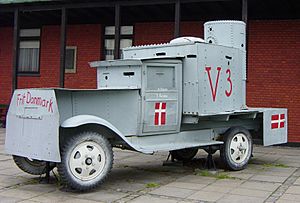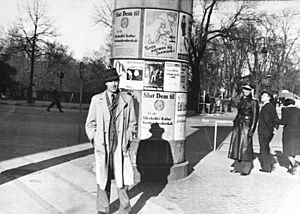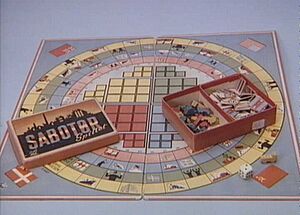Danish resistance movement facts for kids
Quick facts for kids Danish Resistance |
|||||||
|---|---|---|---|---|---|---|---|
| Part of European theatre of World War II and Occupation of Denmark | |||||||
|
Danish resistance fighters battling German soldiers 5 May 1945. Flakhaven, Odense (left), Danish SS soldiers disarmed by resistance fighters in Copenhagen, 1945 (right) |
|||||||
|
|||||||
| Belligerents | |||||||
|
|
|||||||
| Commanders and leaders | |||||||
|
|
|||||||
| Units involved | |||||||
|
Schalburg Corps
|
|||||||
| Casualties and losses | |||||||
| about 850 resistance fighters | |||||||
| 600 Danish civilians | |||||||
The Danish resistance movements were secret groups that fought against the German occupation of Denmark during World War II. When Germany invaded Denmark, the Danish government decided to work with the Germans at first. This meant the resistance movement took a little longer to grow strong compared to other countries.
Members of the Danish resistance did many secret things. They printed hidden newspapers and gathered information for the Allies. They also carried out acts of sabotage, which means damaging enemy property. Important groups included BOPA and Holger Danske, both based in Copenhagen. Smaller groups like the Churchill Club also helped. Resistance fighters killed about 400 Danish people who helped the Germans by 1944.
Contents
Danish Resistance During World War II
Peaceful Resistance: 1940–1943
When Germany invaded Denmark on April 9, 1940, the Danish king and government chose to stay. They worked with the German authorities. The Germans allowed the Danish government to remain in charge. This was because Germany wanted to show Denmark as a "model country" under their control. It was even called the Cream Front because the occupation was relatively easy.
Since Denmark's elected government stayed in power, many Danes felt less need to fight. Daily life in Denmark stayed mostly the same. However, the Germans did make some changes. They controlled what people could read and hear, stopped trade with the Allies, and placed German soldiers in the country. The Danish government asked people not to fight violently. They worried that the Germans would punish Danish citizens severely.
Secret Resistance Groups Form
Soon after the occupation began, some Danes started secret resistance efforts. Danish army officers began sending reports to their British friends in London as early as April 1940. A journalist named Ebbe Munck also helped by moving to Stockholm. From there, he could easily talk to the British.
After Germany attacked the Soviet Union in June 1941, the Germans banned the Danish Communist Party. The Danish police arrested its members. Those who escaped went into hiding and formed secret groups. From October 1942, they printed a hidden newspaper called Land og Folk. This paper was read by many people across the country. By the end of the war, 120,000 copies were printed daily. In early 1943, these groups joined together under BOPA. BOPA also started planning acts of sabotage.
Over time, many other groups formed to fight the occupation. The Hvidsten group received weapons dropped by British planes. Holger Danske successfully planned sabotage and killed people who helped the Germans. The Churchill club was one of the first resistance groups. It was made up of eight schoolboys from Aalborg. They carried out about 25 acts of sabotage. They used homemade bombs to destroy German property and stole German weapons.
When the Germans made the Danish government sign an agreement against communism, a large protest happened in Copenhagen.
Few Danes supported the Nazis before the war, and this continued during the occupation. This was clear in the 1943 elections. Most people voted for the traditional parties or did not vote at all. Not voting was seen as support for the Danish Communist Party. The election was a big disappointment for the Danish Nazi party. The German leader, Dr. Werner Best, gave up plans to create a government with Danish Nazi leader Frits Clausen. This was because Clausen had very little public support.
In 1942–43, resistance actions became more violent. They focused more on sabotage. Various groups connected with the British Special Operations Executive (SOE). The SOE began dropping agents and supplies into Denmark. These drops increased a lot from August 1944 until the end of the occupation. In total, the Allies dropped over 600 tons of weapons and explosives to the Danish resistance. Fifty-three SOE agents were also sent to Denmark.
Military Intelligence Operations
On April 23, 1940, Danish military intelligence officers started talking with British intelligence. They sent their first secret report to Stockholm in autumn 1940. This grew into regular reports about military and political information. By 1942–43, they sent at least one report every week. Also, a person working for Danmarks Radio could send short messages to Britain using the national radio network.
Most of the information was gathered by officers in the Danish army and navy. They reported on political events, where German military units were, and details about the Atlantic Wall defenses in Denmark. In 1942, the Germans demanded that the Danish military leave Jutland. But intelligence work continued. It was done by people in regular clothes or by reserve officers. After Denmark was freed, Field Marshal Bernard Law Montgomery said the intelligence from Denmark was "second to none."
Key Actions of the Resistance
In 1943, the resistance had a huge success. They helped rescue almost all of Denmark's Jewish population. About 7,000 to 8,000 Jewish people were saved from being sent to Nazi concentration camps. The resistance helped transport them to neutral Sweden, where they found safety. The Danish resistance movement has been honored as a group at Yad Vashem in Israel. They are recognized as "Righteous Among the Nations" for their bravery. They asked to be honored as a group, not as individuals.
Another success was disrupting the Danish railway network after D-Day. This slowed down German troops trying to move to France as reinforcements.
By the end of the war, the organized resistance in Denmark had many achievements. They are believed to have killed nearly 400 people from 1943 to 1945. These were Danish Nazis, people who gave information to the Germans, or Danes working for the Gestapo. These individuals were seen as a threat to the Resistance.
The movement lost a little more than 850 members. They were killed in action, died in prison, in Nazi concentration camps, or were executed.
The Danish National Museum has a Museum of Danish Resistance in Copenhagen.
Important Members
- Anton Poul Andersen
- Børge Bak
- Poul Bruun
- Henning Bysted
- Ellen Christensen
- Tom Dencker-Grant
- Gunnar Dyrberg
- Sven Fage-Pedersen
- Povl Falk-Jensen
- Bent Faurschou-Hviid (Flammen)
- Marius Fiil
- Niels Fiil
- Mogens Fog
- Jutta Graae
- Frode Jakobsen
- Jørgen Jenk
- Ove Kampmann
- Christer Lyst Hansen
- Søren Hoff
- Jørgen Kieler
- Ole Lippmann
- Jørgen Strange Lorenzen
- Lone Maslocha
- Kim Malthe-Bruun
- Preben Munch-Nielsen
- Flemming Muus
- John Christmas Møller
- Poul Nielsen
- Knud Pedersen
- Niels Eberhard Petersen
- Poul Kristian Brandt Rehberg
- Jørgen Røjel
- Find Sandgren
- Jørgen Haagen Schmith (Citronen)
- David John Valdemar Schultz (1923–2014)
- Niels Aage Skov
- Thomas Sneum
- Hans Edvard Teglers
- Monica Wichfeld
- Varinka Wichfeld-Muus
What Was the Impact of the Resistance?
Historians have discussed how important the Danish resistance was in the war. Right after the war, many stories said the resistance was very effective. They believed the resistance greatly helped by sabotaging German efforts and providing key information to the Allies.
However, more recently, historians have looked at old records again. They now agree that the resistance was very important for Danish pride and unity after the war. But its direct impact during the occupation was limited. The Germans did not need to send many extra soldiers to control the movement. The resistance did not fight in large battles.
Knud Jespersen, a historian, wrote a book in 2002. He quoted a report that said the resistance in Denmark: "caused problems for the enemy...[and a] big drop in the flow of troops and supplies from Norway [that] surely affected the reinforcements for the battles East and West of the Rhine." Jespersen also found a report that concluded: "the main effect of Danish resistance was to bring back national pride and political unity." He agreed that this was the most important thing the movement did for Denmark.
The Danish Resistance in Books and Movies
Books
- Carol Matas's novels Lisa (1987) and Jesper (1989) tell fictional stories about Danish resistance missions.
- Ken Follett's novel Hornet Flight (2002) is a fictional story about the early Danish resistance.
- Number the Stars (1989) by Lois Lowry is a children's historical fiction novel. It won the Newbery Medal.
- Barry Clemson's novel Denmark Rising (2009) imagines a Denmark that fully resisted the Nazis without violence.
- Povl Falk-Jensen's memoir, Holger Danske - Afdeling Eigils sabotager og stikkerlikvideringer under Besættelsen (2010), tells his story as a leading member of the Holger Danske group.
- Aage Bertelsen's "October '43" (1954) is a true story about the escape of Jewish people to Sweden in 1943.
Film
- Flame and Citron (Flammen og Citronen) (2008) is a drama film. It is based on two famous Danish resistance fighters.
- Miracle at Midnight (1998) is an American TV movie. It is about the rescue of the Jews in Denmark.
- The Boys from St. Petri (1991) is a Danish drama film.
- The Only Way (1970) is a war drama film about the rescue of the Danish Jews.
- This Life (Hvidstengruppen) (2012) is a Danish drama film. It is based on the actions of the Hvidsten Group.
- With the Right to Kill (Med ret til at dræbe, 2003) is a documentary. It looks at the killing of nearly 400 people by the Resistance.
- Omvej til friheden (Detour to freedom) is a TV documentary. It tells the story of two Jewish families trying to escape to Sweden.
- Land of Mine (2015) is a Danish film. It is about young German prisoners of war clearing Nazi beach mines.
- The Shadow in My Eye (Skyggen i mit øje, 2021) is a Danish movie about a bombing during the war.
Music
- "Denmark 1943" is a song by Fred Small. It is on his album I Will Stand Fast.
See also
 In Spanish: Resistencia danesa para niños
In Spanish: Resistencia danesa para niños






